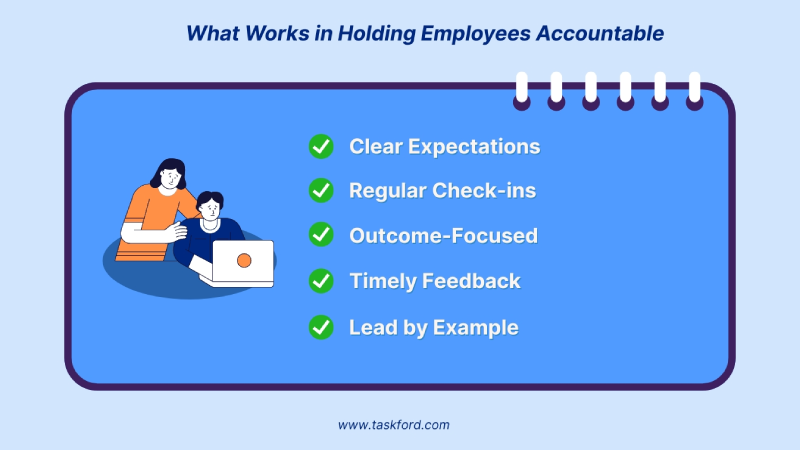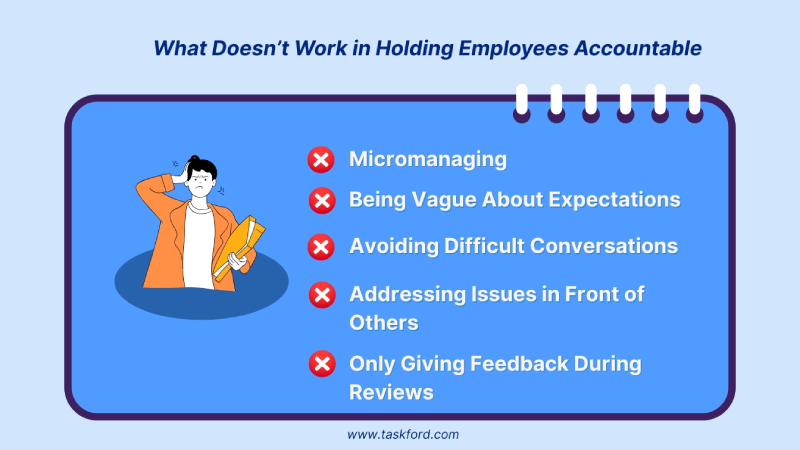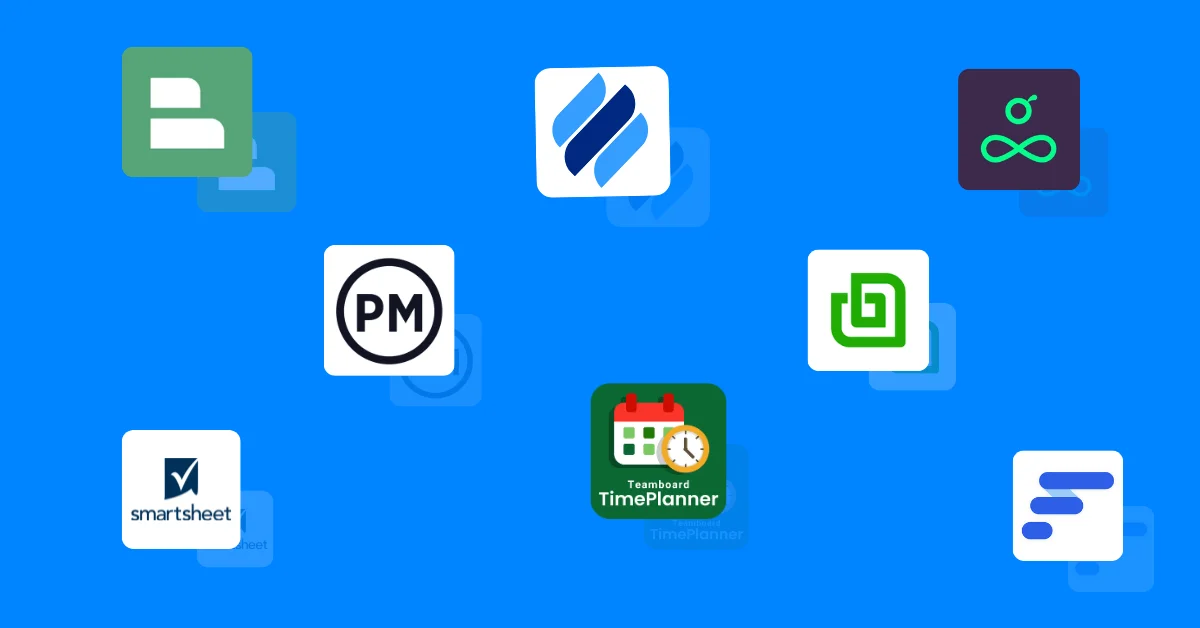How to Hold Employees Accountable: What Works and What Doesn’t
Discover effective strategies to hold employees accountable and build a culture of trust, clarity, and ownership
Knowing how to hold employees accountable is one of the most important skills for any team lead, but it’s also one of the trickiest to get right.
You want your team to take ownership, meet deadlines, and deliver quality work. At the same time, you want to maintain trust, avoid micromanaging, and create a positive environment. The tricky part? Accountability often sits right at the intersection of leadership and tension.
Handled poorly, it can feel like blame or control. Handled well, it builds clarity, consistency, and respect across your team.
In this post, we’ll walk through what actually works when it comes to holding employees accountable, and just as importantly, what doesn’t. Whether you’re managing a small project team or leading a growing department, these insights are built to help you lead with confidence and clarity.
What Is Employee Accountability in the Workplace?
Employee accountability in the workplace means that individuals take responsibility for their tasks, decisions, and performance. It’s about following through on commitments, owning outcomes – both good and bad – and contributing reliably to team goals.
But accountability isn’t just about doing what’s assigned. It also includes:
- Being proactive when problems arise
- Communicating clearly about progress and challenges
- Learning from mistakes rather than avoiding responsibility
- Aligning personal effort with team priorities
In other words, when you hold employees accountable, you're not just making sure work gets done; you're helping build a team culture where people take ownership, support each other, and grow together.
True accountability isn’t enforced—it’s built. And it thrives when expectations are clear, support is consistent, and trust goes both ways.
What Works in Holding Employees Accountable
Holding employees accountable doesn’t have to feel tense or uncomfortable. In fact, when done with consistency and clarity, it helps teams work better together, builds trust, and removes confusion about who’s responsible for what.
Here’s a more in-depth look at what actually works when you want to hold employees accountable in a way that’s healthy, respectful, and productive.

1. Set Clear Expectations from the Start
You can’t hold someone accountable for something that wasn’t clearly communicated. In fact, many accountability issues don’t come from a lack of effort; they stem from unclear priorities, unrealistic timelines, or unbalanced workloads.
If employees are missing deadlines or struggling to follow through, it’s worth asking: Were the expectations clear and realistic from the beginning? Proper planning helps prevent confusion, rework, and overwhelm.
👉 Related: What is Resource Planning? Learn how to balance workloads and assign responsibilities fairly.
Clear expectations involve more than just assigning a task. It’s about aligning on what needs to be done, who owns it, when it’s due, and what “done well” looks like.
What helps:
- Define the deliverable clearly (e.g., “Draft presentation with key metrics and visuals”)
- Be specific with deadlines (e.g., “By end of day Thursday, not ‘sometime this week’”)
- Clarify the level of quality, tone, or review needed
- Use written confirmation—project boards, notes, or chat follow-ups
Example: Instead of saying, “Can you take care of the report soon?” try:
“Can you complete the draft Q3 report with updated revenue data and key charts by Thursday at 3 pm? I’d like to review it before our Friday meeting.”
2. Have Consistent, Constructive Check-Ins
Don’t wait for something to go wrong to bring up accountability. Regular check-ins help prevent misunderstandings, surface early signs of delay, and reinforce that ownership is shared, not one-sided.
Integrating time tracking or task updates into your check-ins helps you spot delays early and adjust workloads before things fall behind
What helps:
- Schedule recurring 1:1s or brief project syncs
- Ask open questions: “What’s working well? What feels stuck?”
- Show interest in progress, not just completion
- Be willing to offer help without jumping in to fix things
Example Questions:
- “What’s the biggest blocker for you right now?”
- “Is the deadline for this still realistic given other priorities?”
- “Anything you need from me to stay on track?”
These conversations help reinforce ownership while showing that you’re a partner, not just a task-checker.
3. Align Accountability with Outcomes, Not Just Activity
One of the most common traps in team leadership is rewarding busyness instead of effectiveness. Just because someone is working long hours or juggling many tasks doesn’t always mean they’re achieving the desired outcomes.
When holding employees accountable, the focus should be on results: Was the work completed? Did it meet the goals? Did it move the project forward?
What helps:
- Define success with clear metrics or goals
- Ask for outcome-based updates: “What did this accomplish?”
- Avoid measuring performance by activity level alone
Example: Instead of “Did you work on the client materials this week?” ask,
“Did we complete the deck in a way that reflects the client’s feedback from Monday?”
Shifting the conversation to impact promotes responsibility and encourages critical thinking.
4. Give Timely, Actionable Feedback
Accountability without feedback is like driving without a steering wheel—you can’t adjust, improve, or course-correct in real time. Waiting too long to speak up about an issue often leads to missed opportunities for learning and growth.
What helps:
- Share feedback while the situation is still fresh
- Be specific: focus on what happened, not just how you felt about it
- Describe the impact of the action or inaction
- Invite discussion and reflection instead of delivering a one-sided critique
Example:
“I noticed the campaign summary was sent out without the analytics section. That’s a key part that the team was waiting on, and it slowed down their work. Can we talk about what happened and how we can make sure it doesn’t get missed next time?”
This kind of feedback reinforces accountability without being punitive.
5. Recognize When Accountability Is Done Well
Accountability isn’t just about catching what went wrong; it’s just as important to notice and celebrate when team members follow through, take ownership, and deliver results without needing to be reminded.
When you highlight these moments, you reinforce the behavior and show your team that responsibility and reliability are valued.
What helps:
- Give specific praise: “Thanks for owning that,” or “I appreciate how you followed through despite the quick turnaround.”
- Acknowledge progress during meetings or check-ins
- Let the team see each other’s contributions – it builds a shared culture of accountability
Even small gestures, like saying thank you or spotlighting someone in a team huddle, can strengthen motivation and ownership.
6. Lead by Example – Accountability Starts with You
Team members watch how you show up. If you expect them to meet deadlines, follow through on commitments, or own mistakes, you need to do the same. Accountability is as much about what you model as what you manage.
What helps:
- Be consistent in your communication and follow-ups
- Acknowledge when you drop the ball, and correct it
- Avoid shifting blame or deflecting tough feedback
- Keep your own commitments visible to the team
Example: If you miss a deadline, don’t brush it off. Say:
“I didn’t get that follow-up to you in time, and I know that impacted your schedule. That’s on me – I’ll make sure it’s prioritized now.”
This kind of honesty makes accountability feel fair and team-oriented, not top-down.
When you build these practices into your leadership style, accountability becomes less of a performance issue and more of a team strength. It shifts from being something people fear to something they take pride in.
What Doesn’t Work in Holding Employees Accountable
Before we look at the right way to hold employees accountable, it’s important to understand what doesn’t work. These common habits often come from a place of wanting to help or protect the team, but they usually lead to confusion, frustration, or disengagement.

Here are some approaches to avoid:
1. Micromanaging
Micromanagement is the antithesis of accountability. When leaders hover over every detail of an employee’s work, they signal a lack of trust, which erodes morale and stifles initiative. Employees who feel micromanaged are less likely to take ownership of their tasks, as they perceive their work as being controlled rather than self-directed.
A 2023 study by SHRM found that 69% of employees reported lower job satisfaction under micromanaging supervisors.
2. Being Vague About Expectations
When tasks are assigned without clear deadlines, goals, or context, it leaves too much room for interpretation. People may think they understand what’s needed, but end up going in a different direction.
3. Avoiding Difficult Conversations
If someone isn’t meeting expectations and it’s never addressed, the issue doesn’t go away—it usually gets worse. Skipping these conversations can lead to ongoing frustration or uneven workloads across the team.
4. Addressing Issues in Front of Others
Bringing up mistakes or missed deadlines in a group setting can lead to embarrassment and defensiveness. It makes it harder for the person actually to hear the feedback and move forward.
5. Only Giving Feedback During Reviews
Saving feedback for performance reviews or formal check-ins limits chances to adjust and improve in real time. People need regular guidance to stay on track, not just a summary months later.
Avoiding these patterns creates a healthier space for accountability to grow. It’s easier for your team to stay aligned when expectations are clear, support is consistent, and conversations happen at the right time.
How to Build a Culture of Accountability
A culture of accountability drives performance and engagement by empowering employees to take ownership of their work. Here’s how to build it effectively and avoid common pitfalls.
✅ Lead by Example
Leaders must model accountability by owning decisions, admitting mistakes, and meeting commitments.
For example, delivering feedback on time shows that accountability matters. A 2023 study found that teams with accountable leaders are 28% more likely to take responsibility.
✅ Promote Open Communication
Create a safe space for employees to share concerns or admit errors without fear. Weekly check-ins or anonymous surveys foster transparency. Google’s 2024 study shows teams with psychological safety are 40% more accountable.
✅ Connect Work to Purpose
Help employees see how their tasks contribute to the bigger picture. For example, explain that their prompt customer responses strengthen client relationships, which drives company growth. When employees understand the “why” behind their work, they’re more motivated to take responsibility.
✅ Support Accountability with the Right Systems
Accountability grows more naturally when your team has the structure to support it.
Tools like Enterprise Resource Planning and Resource Planning Software help align workloads, deadlines, and responsibilities—so everyone knows what they’re working on, when it's due, and how it contributes to team goals.
✅Recognize Accountability
Celebrate employees who take ownership, like praising someone for solving a client issue proactively. A quick shout-out in a team meeting or a thank-you note reinforces positive behavior and inspires others to step up.
Final Thoughts
Accountability isn’t about control; it’s about clarity, trust, and follow-through. When team members know what’s expected, feel supported, and see strong examples from leadership, accountability becomes part of the team’s rhythm, not a reaction to problems.
As a team lead, focus on setting clear expectations, checking in regularly, and giving your team the tools and space to take ownership. Over time, these small habits build a stronger, more accountable team culture.
Related Resources:
- Top 7 Resource Planning Software
- explains resource management Key Definition, Must-Know Terms
- Small Business Time Tracking Comparison 2025
Making work simpler,
smarter, and more connected
Join our waitlist and be notified first.

Related Blog
Subscribe for Expert Tips
Unlock expert insights and stay ahead with TaskFord. Sign up now to receive valuable tips, strategies, and updates directly in your inbox.






